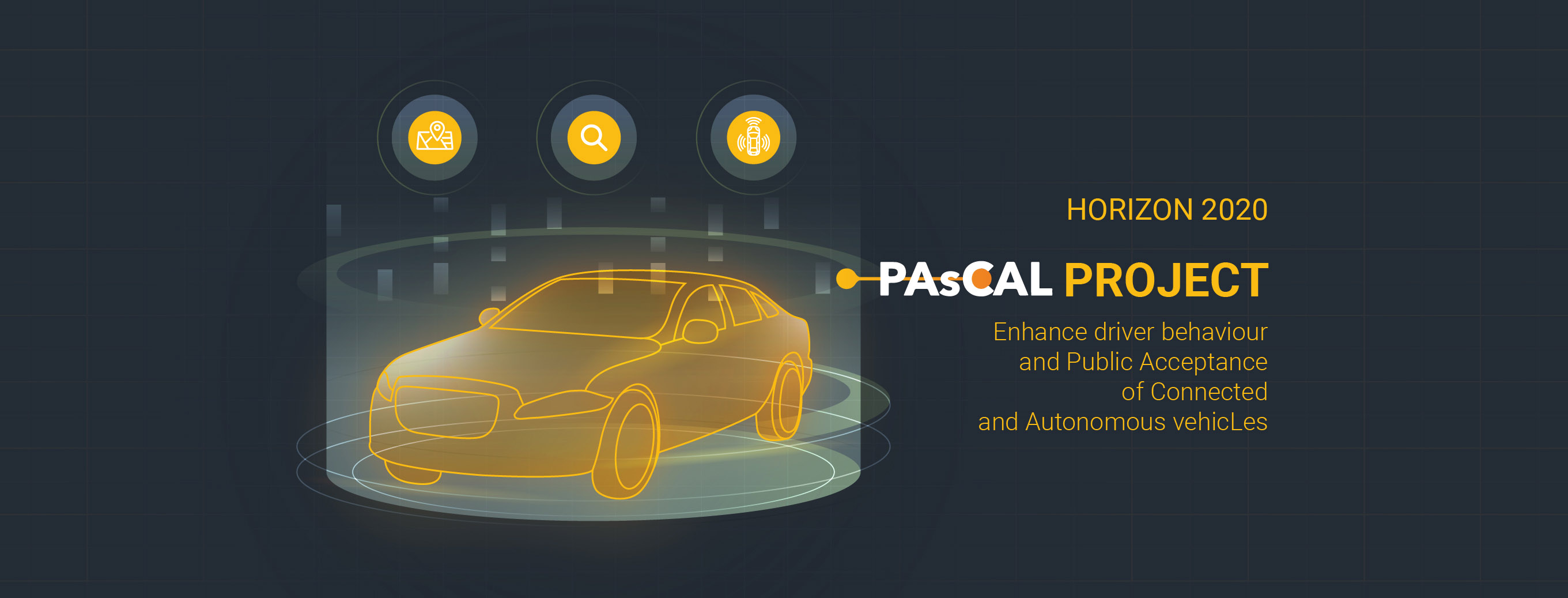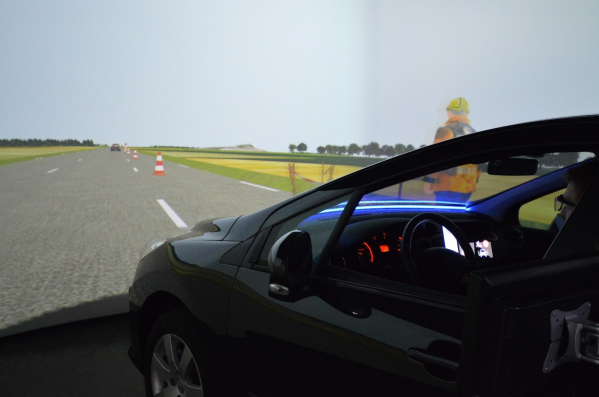
Enhance driver behaviour and Public Acceptance of Connected and Autonomous vehicLes
PAsCAL is an international project aimed to develop a multidimensional map of public acceptance of higher levels of Connected and Autonomous Vehicles (CAV), pointing out any critical issues on the matter, particularly investigating the new “driver” needs considering different modes and mobility services. PAsCAL’s goal is to create a “Guide2Autonomy” (G2A), a set of guidelines and recommendations aimed at accelerating the user-friendly evolution of connected automated vehicles and transport systems.
Recommendations
Recommendations are now available in PAsCAL's G2A
Latest news
-
 November 2022
November 2022CAV acceptance: simulation experiments results (French)
Hybrid EventAn event will be held UBFC both online and on-site.
Experiment conditions and results will be presented and discussed by researchers and participants to the tests will bring their experience to the discussion.
Attendees in presence will be given the opportunity to visit the simulation platforms.
Agenda:
Introduction to CAVs
Presentation of XP1 and its results
Tesimony of a XP1 volunteer participant
Presentation of XP2 and its results
Q/A
Speakers of the event:
Maxime Larique
Nicolas… -
NewsNovember 2022
PAsCAL at the TRA 2022 In Lisbon
News postPAsCAL will showcase its activities and results at the TRA 2022, which is taking place in Lisbon from today till Thursday 17th.
Here is when you may follow us:
Monday 14 November at 17-18.30
Poster Pitch Presentations: Smart Solutions and society700 Designing CAVs with vulnerable travellers in mind: Requirements to bridge the gap to full accessibility / Friederike L. Kühl, Etelätär Innovation, Estonia
Tuesday 15 November at 8.30-10
Podium presentations: Connected and Automated Multimodal… -
NewsOctober 2022
HOW DO WE WILL INCREASE ACCEPTANCE OF AUTONOMOUS VEHICLES? PASCAL PROJECT SHOWS YOU HOW!
EventCELEBRATING THE ACHIEVEMENTS OF PASCAL
For more than 3 years, H2020 PAsCAL project aimed at enhancing driver behaviour and Public Acceptance of Connected and Autonomous vehicLes.
PAsCAL’s ultimate goal is to create a“Guide2Autonomy” (G2A), a set of guidelines and recommendations aimed at accelerating user-friendly evolution of connected automated vehicles and transport systems.
You are invited to presentations and discussions taking place in Belval that kick off at 17:00 on October…
Latest papers
-
September 2022
Driverless Vehicles: Minding the Visually Impaired from the Start
This policy papare written by EBU for the PAsCAL Project explains which safety and accessibility issues do Connected and Autonomous Vehicles (CAVs) pose for the inclusion and personal mobility of visually impaired people.
-
June 2021
Consequences of autonomous vehicles: Ambivalent expectations and their impact on acceptance
Connected and autonomous vehicles (CAVs) are within reach of widespread deployment on public roads, but public perceptions are ambivalent. The objective of the present research was to assess expectations about the consequences of CAV introduction. These expectations should explain CAV acceptance, but their relative importance is poorly understood. We conducted a survey with a representatively drawn panel sample (N = 529) from France, Germany, Italy, and the UK. The survey consisted of a large item pool of expected consequences from CAV introduction, as well as general and affective evaluation of CAVs, ease of use, and behavioral intention to use CAVs. Exploratory factor analysis revealed four facets of expected consequences: road safety, privacy, efficiency and ecological sustainability. On average, expectations were mostly positive for ecological sustainability and safety, but negative for privacy. At the same time, substantial variance existed between respondents and between countries. For safety and efficiency, improvement was expected by a third of respondents, while another third expected worsening. Respondents from Italy expected more positive consequences for safety, while respondents from both France and Germany expected more negative consequences for privacy. To different degrees, all four facets predicted the intention to use CAVs in a structural equation model, primarily via affective evaluations. For policy makers, manufacturers, and service providers, understanding the trade-offs inherent to different CAV solutions will be central to ensure citizens’ needs are respected.
-
November 2020
Legal issues in automated vehicles: critically considering the potential role of consent and interactive digital interfaces
Some of the first ‘automated’ vehicles to be deployed on our roads will require a system of shared driving with a human driver. While this creates technical and operational challenges, the law must also facilitate such a transfer. One method may be to obtain the driver’s consent to share operational responsibility and to delineate legal responsibility between vehicle and driver in the event of an accident. Consent is a voluntary agreement where an individual is aware of the potential consequences of their consent, including the risks. The driver of a partially automated vehicle must be informed of potential risks before giving consent to share operational responsibility. This paper will refer to the inherent dangers associated with shared operational responsibility, in particular where there has been a request for the driver to take back control from the automated vehicle during the journey. Drivers are likely to experience delay in regaining situational awareness, making such operational transfers hazardous. It is argued that where an interactive digital interface is used to convey information, such as driver responsibility, risk and legal terms, drivers may fail to sufficiently process such communications due to fundamental weaknesses in human–machine interaction. The use of an interactive digital interface alone may be inadequate to effectively communicate information to drivers. If the problems identified are not addressed, it is argued that driver consent may be inconsequential, and fail to facilitate a predicable demarcation of legal responsibility between automated vehicles and drivers. Ongoing research into automated vehicle driver training is considered as part of the preparation required to design driver education to a level whereby drivers may be able to sufficiently understand the responsibilities involved in operating a partially automated vehicle, which has implications for future driver training, licensing and certification.
Latest press releases
-
November 2022
PAsCAL, YOUR GUIDE TO AUTONOMY
The PAsCAL project, funded by the European Commission, is coming to an end after three and a half years with a final result – the “Guide2Autonomy” (G2A). Today's cars already integrate several features of automation (like autopilot and lane assistance) and therewith already function at a level 3 of automation. Connected and Autonomous Vehicles (CAVs) are an inherent part of today’s new mobility and will be even more present in the near future. More is to come. -
November 2022
CONNECTED AND AUTONOMOUS VEHICLES (CAV): PAsCAL PROJECT UNVEILED IN A PODCAST SERIES OF 7 EPISODES ON AIR FROM NOVEMBER 15
Discover the different phases and results obtained by the PAsCAL Project over its three-year work through the voice of its protagonists. Most of today’s vehicles are at least partially connected and equipped with some autonomous functions. This is an increasing trend, until they become totally autonomous driving vehicles. A very near future, indeed, which however raises important questions, such as, in the first place: -
November 2022
PAsCAL Project at TRA Conference 2022
The event, scheduled for November 14-17, 2022 in Lisbon, will be an opportunity to learn about the PAsCAL Project's contribution to defining the implications of the introduction of connected and autonomous vehicles (CAVs) in society TRA 2022 - one of Europe's largest mobility and transport events – scheduled this year for Nov. 14-17 in Lisbon, will host valuable contributions from the PAsCAL project in several sessions.